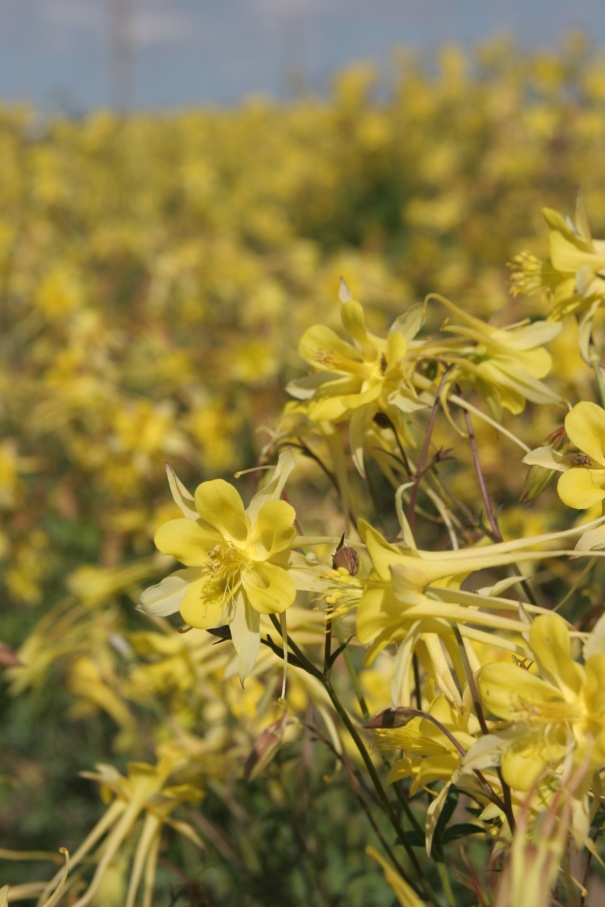Golden Columbine in the Landscape

Stephen Love, University of Idaho
Scientfic Name: Aquilegia chrysanthaCommon Name: Golden Columbine
Description: Golden columbine is a hardy, very long-lived perennial. The plants are robust and often grow to a height greater than 3 feet. The foliage consists of dense, attractive, medium-green, divided leaves. The nodding flowers grow on long, slender stems. The large, lemon-yellow blooms have long. Bloom period 4 to 6 weeks long in summer, with some rebloom in the fall. Golden columbine is adapted to a wide range of growing conditions and can withstand moderately dry conditions, making it a good subject for dry shade or beds and borders in full sun.
Native Habitat: Aquilegia chrysantha is native to the southern Rocky Mountains, mainly in Arizona and New Mexico. It grows in moderately dry wooded sites and moist riparian areas at elevations ranging widely from 1,200 to 10,500 feet.
Cultural Requirement
Soil: Tolerates a wide range of soils, with best growth on loams and clays. Can tolerate moist conditions, but soil must be well-drained. Withstands soils with high pH.
Moisture Tolerance: Thrives under a wide range of soil moisture conditions, from moist (well-drained) to moderately dry. Plants will not survive under non-irrigated conditions in climates with less than 15 to 20 inches of annual precipitation, but will do well in dry places with supplemental irrigation during hot summer months.
Sun/Shade/Preference: Adapted to part shade but will grow well and bloom freely in site with full sun to moderate shade.
Transplanting: Tolerates transplanting well, both from pot to pot and from pot to garden. Can withstand long-term culture in pots up to one gallon size. Plants grow fairly rapidly after transplanting but usually do not bloom the first year from seed.
Propagation: Easily grown from seed. Six to 8 weeks of cold stratification is required. Germination rate is typically high. Once emerged, seedlings are easy to handle and transplant nicely when they have 4 to 6 true leaves. Plants can also be propagated vegetatively using crown divisions or by rooting basal stem cuttings. Cuttings should be rooted under mist. No hormones are required but sterile conditions and/or fungicide treatments to control root rots may be required.
Maintenance (pruning, fertilization, deadheading, division, irrigation, etc): Minimal maintenance is required. Remove spent flower stems to improve appearance and encourage additional bloom. If leaves begin to show signs of drought stress, apply 2 to 3 inches of supplemental irrigation. A light application of nitrogen fertilizer will help invigorate established plants.
Insect, disease, or other problems: Golden columbine has occasional problems with aphids, spider mites, and powdery mildew. The foliage usually remains attractive until late summer. If the leaves show damage from disease or insects in late summer, shear the leaves at the base to encourage regrowth of new, attractive foliage.
Landscape Value
Use in the Landscape: Golden columbine can fill a number of roles in the landscape, including addition of color to shady areas and accent for taller plants in beds, borders, and rock gardens. This plant will contribute to either formal or naturalized designs and can be incorporated almost anywhere a medium-sized perennial is required. It can also be used in decorative pots.
Weediness/Invasive Potential: Golden columbine is a clump-forming species and does not spread via rhizomes. It will occasionally produce volunteer seedlings immediately around the parent plant. These are easily controlled and do not represent invasive behavior.
Foliage: Foliage of golden columbine forms a dense, large mound. The leaves are twice divided, terminating in groups of three leaflets. The leaflets are relatively large and medium green in color.
Flower: Numerous, dense panicles of flowers extend up to 18 inches above the foliage. Lemon-yellow flowers have long spurs, are about 3 inches long, and nodding. The flowers are very attractive to hummingbirds.
Timing: June-August.
Fruit: The fruit is a terminal capsule-like structure called a follicle. It is divided into five papery segments, each holding numerous oval, shiny, black seeds.
Form: Prior to bloom, plant form is mounding to densely spherical. During bloom, open panicles create a more upright to spreading, open architecture.
Texture: Moderately coarse.
Ultimate Size: Prior to bloom, the plants are 12 to 15inches tall and with similar width. In-bloom the plants are 30 to 40 inches tall and almost as wide.
Rate of Growth: Golden columbine grows slowly during establishment, but increases in size rapidly once full-sized leaves begin to appear. The plants seldom bloom the first year after transplanting to the garden.
Suggested Plant Partners: Place golden columbine around trees and shrubs such as Crataegus douglasii, Betula occidentalis, Acer grandidentatum, Ribes aureum, Amelanchier alnifolia, and Cornus sericea. Complementary grasses include Deschampsia caespitosa, Poa secunda, and Sporobolus airoides. Mix with other perennials such as Geranium viscosissimum, Iliamna rivularis, Iris missouriensis, and Penstemon whippleanus.
Availability: A fairly common offering among native plant nurseries, both local and mail-order. Seed can be purchased from native plant seed suppliers.
Cultivars: ‘Denver Gold’, ‘Yellow Star’, ‘Yellow Queen’, ‘Gold Queen’.
References:
Nicholls, G. 2002. Alpine Plants of North America. Timber Press, Portland, OR.
Nold, R. 2008. High and Dry: Gardening With Cold-Hardy Dryland Plants. Timber Press, Portland, OR.

